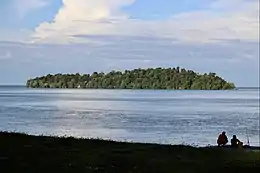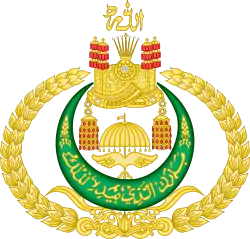| Abdul Hakkul Mubin | |||||||||
|---|---|---|---|---|---|---|---|---|---|
| 13th Sultan of Brunei | |||||||||
| Reign | 1661–1673[1] | ||||||||
| Predecessor | Muhammad Ali | ||||||||
| Successor | Muhyiddin | ||||||||
| Born | Abdul Hakkul Mubin Brunei | ||||||||
| Died | 1673 Pulau Chermin, Brunei-Muara, Brunei | ||||||||
| Burial | Pulau Chermin Royal Cemetery, Brunei-Muara, Brunei | ||||||||
| Spouse | Pengiran Siti Nur Alam | ||||||||
| Issue Detail | Pengiran Muhammad Alam Pengiran Muda Amir Pengiran Abdul Rauf Pengiran Anak Tengah | ||||||||
| |||||||||
| House | Bolkiah | ||||||||
| Father | Pengiran Bendahara Pengiran Muhammad | ||||||||
| Mother | Pengiran Anak Tuah binti Al-Marhum Sultan Muhammad Hassan | ||||||||
| Religion | Islam (Zaydism) | ||||||||
Abdul Hakkul Mubin ibni Muhammad Panjang (Jawi: عبد الحق المبين; reign 1661–1673), also known as Abdul Mubin or Al-Marhum di Pulau, was the 13th Sultan of Brunei. He was involved in the Brunei Civil War and ruled the sultanate from 1660 to 1673, after killing his uncle, Sultan Muhammad Ali.
Reign
Background
Pengiran Muda Bongsu, Sultan Muhammad Ali's own son, was a party to an incident. Pengiran Muhammad Alam, the prince's opponent in the cockfight and the son of Pengiran Bendahara Abdul Hakkul Mubin, was assassinated by Bongsu in revenge after the prince lost. The prince was therefore sentenced to death by his father, the sultan, in accordance with the legal maxim that, as stated in the fifth and eighth clauses on gisas (retribution), death is punishable by death.[2] Pengiran Abdul Hakkul Mubin requested to kill Pengiran Bongsu himself at Sultan Muhammad Ali's palace but was quickly turned down.[3][4] Sultan Muhammad Ali insisted that only he has the power to punish, thus he refused to allow his son to be put to death. Despite the fact that the Sultan gave him permission to enter the palace to look for the killer prince, who was missing, in the book Mahkota Berdarah. The prince had left the palace by the time he entered.[5] Because of the implied implication, which infuriated Pengiran Abdul Hakkul Mubin, thus causing him to murder everyone inside the palace.[6] Pengiran Abdul Hakkul Mubin then garroted Sultan Muhammad Ali on 16 November 1661, during Asr prayer.[7]
Succession

After Sultan Muhammad Ali was slain by the Bendahara, Brunei was without a Sultan. Due to his close familial ties to the outgoing sultan, Bendahara was chosen as the next sultan to rule the nation.[8][9] Pengiran Bongsu Muhyiddin, who is none other than the younger brother of Sultan Abdul Jalilul Jabbar from the same mother, received the title of Pengiran Bendahara Seri Maharaja Permaisuara from Sultan Abdul Hakkul Mubin while he was still in power.[10] In order to placate the supporters of the outgoing Sultan, Muhyiddin, Muhammad Ali's nephew and son-in-law, was given the title.[11]
The nation was initially at peace. But, despite the seeming tranquillity, there was still a smoldering resentment of Sultan Hakul Abdul Mubin. In order to overthrow him, several of Sultan Muhammad Ali's supporters pleaded with Bendahara Muhyidin. Bendahara Muhyiddin first believed it to be the wrong course of action. But eventually, he came around and helped arrange the ouster of Sultan Hakkul Abdul Mubin. The first action he and his soldiers took was to cause a commotion for the palace and the nearby homes. By jabbing their spears into the palace and homes, they caused the disruptions. It was simple for the rebels to carry out the attacks because many of them had jobs at the palace.[5]
Brunei Civil War
In contrast to the Pengiran Bendahara Muhyiddin, Sultan Abdul Hakkul Mubin moved the administrative center from Kota Batu to Pulau Chermin.[12][13] The relocation was carried out under the direction of the recently appointed Pengiran Bendahara Muhyiddin, with the intention that Abdul Hakkul Mubin would stay put to weather the crisis that existed prior to the Brunei Civil War.[14] After relocating to the island, Muhyiddin established his rule around Kampong Ayer and proclaimed himself the 14th Sultan of Brunei, igniting the nation's first civil war.[15][16] Inquiring as to why Muhyiddin had not set up residence on the island, Sultan Hakkul Abdul Mubin's troops were startled to discover that Muhyiddin had erected the Sultan's yellow flag for himself.[5]
Sultan Hakkul Abdul Mubin constructed a fort 10 miles (16 km) from Kota Kinabalu while he retreated to Kinarut, after he was unable to regain control of Kampong Ayer. He was able to fend off Sultan Muhiyiddin's raids from here with the help of the neighborhood Bajaus and Dusuns, even killing a number of the sultan's cheterias. The fort was carefully positioned on a hill, next to two rivers, with a view of a few small islands in the South China Sea. Legend has it that Sultan Hakkul Abdul Mubin spent roughly ten years in the fort before moving on to become the Sultan of Kinarut, where he, among other people, was able to stop piracy activities in the region.[5]
When Sultan Muhyiddin's forces lost a battle, the conflict moved back into Brunei, and Abdul Hakkul Mubin relocated to Pulau Chermin.[17][18] Muhyiddin then enlisted the aid of the Sultan of Sulu, asked for more Suluan troops, and negotiated a payment for the eastern Sabah territory.[19] After Sultan Muhyiddin's soldiers arrived on the island, no battles have broken out because Tanjong Kindana's shelling has demolished most defenses,[20] and Sultan Abdul Mubin's execution at the island's Great Mosque has put a stop to the civil war.[21] He has fired most of the regalia into Brunei Bay prior to his execution.[22] At the Pulau Chermin Royal Cemetery, Abdul Hakkul Mubin was laid to rest.[23] There had been no grave discovered on Pulau Chermin, despite them saying Sultan Abdul Hakkul Mubin being buried there.[9]
Personal life
Sultan Abdul Hakkul Mubin was the third son of Yang Amat Mulia Paduka Sri Pangiran Bendahara Sri Maharaja Pengiran Muhammad Panjang, also known as Raja Dungu, and his wife, Pangiran Tuah, daughter of Sultan Muhammad Hasan. He was married to Paduka Sri Raja Istri Pangiran Siti Nur Alam, the eldest daughter of the previous mentioned Sultan, and together they had 4 children, whom were:
- Pengiran Muhammad Alam
- Pengiran Muda Amir
- Pengiran Abdul Rauf
- Pengiran Anak Tengah
References
- ↑ "Pusat Sejarah Brunei - Sultan - Sultan Brunei". www.history-centre.gov.bn. Retrieved 7 April 2023.
- ↑ Gin, Ooi Keat; King, Victor T. (29 July 2022). Routledge Handbook of Contemporary Brunei. Taylor & Francis. ISBN 978-1-000-56864-6.
- ↑ Awang.), Mohd Jamil Al-Sufri (Pehin Orang Kaya Amar Diraja Dato Seri Utama Haji (2002). Sejarah sultan-sultan Brunei menaiki takhta (in Malay). Pusat Sejarah Brunei, Kementerian Kebudayaan, Belia dan Sukan. p. 13. ISBN 978-99917-34-25-5.
- ↑ Jurnal Beriga (in Malay). Dewan Bahasa dan Pustaka Brunei, Kementerian Kebudayaan, Belia dan Sukan. 2009. p. 74.
- 1 2 3 4 "The Mirror Island and The Civil War". The Mirror Island and The Civil War. Retrieved 7 April 2023.
- ↑ Ibrahim (Haji.), Abdul Latif bin Haji (2003). Brunei Darussalam: rantisan sejarah dan budaya (in Malay). Akademi Pengajian Brunei, Universiti Brunei Darussalam. p. 91. ISBN 978-99917-1-104-1.
- ↑ Santos, Jason (19 December 2020). "Brunei or Sulu: an ancient territorial dispute". thevibes.com. Retrieved 6 April 2023.
- ↑ Sidhu, Jatswan S. (22 December 2009). Historical Dictionary of Brunei Darussalam. Scarecrow Press. pp. XXIX. ISBN 978-0-8108-7078-9.
- 1 2 History, Borneo (19 September 2016). "Borneo History: The Lost History of Sultan Abdul Hakkul Mubin the Raja of Saba' Kinarut". Borneo History. Retrieved 7 April 2023.
- ↑ "Kesultanan Brunei Darussalam | Kerajaan Nusantara". www.kerajaannusantara.com. Retrieved 7 April 2023.
- ↑ "Civil war wrecks chaos in the country". The Brunei Times. Archived from the original on 14 June 2012. Retrieved 20 January 2012.
- ↑ Duraman (Haji), Sulaiman Haji (2009). Kenali negara kita (in Malay). Dewan Bahasa dan Pustaka Brunei, Kementerian Kebudayaan, Belia dan Sukan. p. 18. ISBN 978-99917-0-638-2.
- ↑ "Civil war wrecks chaos in the country". The Brunei Times. Archived from the original on 14 June 2012. Retrieved 20 January 2012.
- ↑ "Civil war wrecks chaos in the country". The Brunei Times. Archived from the original on 14 June 2012. Retrieved 20 January 2012.
- ↑ History for Brunei Darussalm. EPB Pan Pacific. 2008. p. 44. ISBN 978-99917-2-545-1.
- ↑ Gin, Ooi Keat; King, Victor T. (29 July 2022). Routledge Handbook of Contemporary Brunei. Taylor & Francis. ISBN 978-1-000-56864-6.
- ↑ "Pulau Cermin - Brunei's Historic Island". Pulau Cermin - Brunei's Historic Island. Retrieved 24 July 2022.
- ↑ "Civil war wrecks chaos in the country". The Brunei Times. Archived from the original on 14 June 2012. Retrieved 20 January 2012.
- ↑ "Civil war wrecks chaos in the country". The Brunei Times. Archived from the original on 14 June 2012. Retrieved 20 January 2012.
- ↑ Rahman, Muhammad A. (1966). Rangkaian tawarikh negeri sabah (in Malay). Al-Ahmadiah Press. p. 55.
- ↑ Awang.), Mohd Jamil Al-Sufri (Pehin Orang Kaya Amar Diraja Dato Seri Utama Haji (1997). Tarsilah Brunei: Zaman kegemilangan dan kemasyhuran (in Malay). Jabatan Pusat Sejarah, Kementerian Kebudayaan Belia dan Sukan. pp. 193–194.
- ↑ Vienne, Marie-Sybille de (9 March 2015). Brunei: From the Age of Commerce to the 21st Century. NUS Press. p. 65. ISBN 978-9971-69-818-8.
- ↑ Singapore, Royal Asiatic Society of Great Britain and Ireland Malaysian Branch (1965). Journal of the Straits Branch. p. 28.
